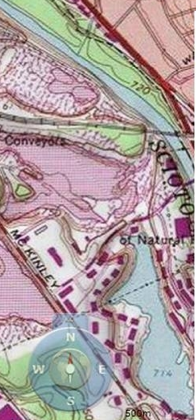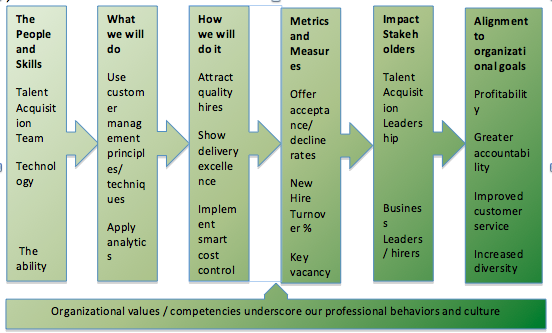 About a year ago, I was participating in a series of team meetings when I noticed that one question kept resurfacing: “How can we demonstrate the value of talent acquisition?” While the discussion moved to other topics, this question remained unanswered.
About a year ago, I was participating in a series of team meetings when I noticed that one question kept resurfacing: “How can we demonstrate the value of talent acquisition?” While the discussion moved to other topics, this question remained unanswered.
Cost, quality, and speed have underpinned the value proposition of the talent acquisition function for many years. It has been defined by metrics such as productivity, process and channel efficiency, full/sub-cycle time, and the results of satisfaction surveys. Yet, it has become clearer to me that value in talent acquisition is no longer being adequately communicated and translated to our customer base. We need a new way to demonstrate value beyond the walls of our own function. We need to better articulate how and why talent acquisition contributes to the overall worth of the organizations we work for.
Here, I make my case for a new kind of value mapping that centers around talent acquisition first and foremost. Value mapping talent acquisition can deliver better results, with more focused associated costs and impactful communication.
Value: A Simple Definition
Value, at its most simple, is relative worth. So, the first question we must ask ourselves is, “How does my organization as a whole depict its relative worth?”
For some organizations, relative worth could be defined as shareholder value, or competitive advantage, or even enterprise value. Whichever principle or methodology an organization subscribes to, generally they regard their value as something that:
- is sustainable over the long term
- is reliant on all parties within a company to achieve
- has competitive advantage as a key pillar
Based on this, talent acquisition should consider its relative worth in the same light as the organization.
The challenge, however, is to demonstrate or measure the value of talent acquisition at an organizational level without reducing it to an administrative process or overhead. This is where value mapping comes in.
Value Mapping
One tool used to demonstrate and visually chart the achievement of value is a value map. In essence, this shows how an organization intends to achieve its strategic goals and create (or preserve) value. The reason we use a visual map to do this is because it is easier to generate common understanding around one, simple, and concise diagram than it is around many pages of text — as strategy documents tend to be.
The goals set out in a value map attempt to tie together the components of shareholder/enterprise value and competitive advantage. They map out the stakeholders and processes for each — and simplicity is key.
Ultimately, value mapping must not only set out the critical actions and goals for success, it must clearly communicate these to ensure they become central to the decisions that are made each and every day. It must demonstrate a clear cause-effect relationship that all the stakeholders can align their own actions against.
Articulating the value of talent acquisition as a function, via a value map, goes one step further than this to put talent acquisition strategy at the center of the business priorities and objectives.
Talent Acquisition at the Center of Value
We may know that talent acquisition is a key contributor to an organization’s overall strategy by nature of its function: attracting talent. Most organizations would agree that their people are:
- their greatest differentiator
- at the core of competitive advantage
- central to the achievement of key business goals
- the external ‘face’ to the market re: candidate and customer experience
Yet talent acquisition is rarely measured in a way that reflects this.
‘Traditional’ talent acquisition metrics are often those such as channel efficiency, full/sub-cycle time, etc. While these metrics are good measures of productivity and efficiency, they say nothing of the value that the function adds to the organization. In fact, these measures do not typically link directly to business strategy at all. There lies the central issue with the ways we currently communicate the value of talent acquisition within an organization.
In building a talent value map, talent acquisition initiatives are prioritized and aligned to organizational strategy. The map also enables the entire business to visualize how talent decisions translate into organizational ‘relative worth’.
When building the map, two issues must be considered in tandem:
- value preservation (how we keep what we already have/continue to run the business well)
- value creation (what we need to do differently/how we build a sustainable competitive advantage)
Here’s How the Map Might Look
A talent value map is a clear and simple way of visualizing all the strategic inputs that a company may require to reach its objectives. In the above sample, the map was created starting with organizational goals (i.e. right to left) yet delivery will start with the people and skills (i.e. left to right).

Which Metrics?
In creating a talent value map, the metrics chosen will depend upon how strategic and future-focused the talent acquisition strategy is within the organization. Whichever metrics are chosen, consider those that go beyond “departmental successes and challenges.” While it is often relevant to demonstrate the efficiency of the talent acquisition team, efficiency alone is not enough to demonstrate value.
The map should include metrics that have also enhanced alignment and focus of the talent acquisition team to the long-term goals of the organization. The triumvirate of cost, quality, and speed is still alive and relevant in talent acquisition, but we must demonstrate more value than this.
When considering which metrics to use in your talent value map, consider how the map will help you to answer this question: “At the end of the year, how will we know if we’ve been successful?” As an example, Dr. John Sullivan’s recent ERE article, “High-impact Strategic Recruiting Metrics for WOWing Executives”, a number of different measures and metrics are cited which target business-impact. Whichever metrics are targeted as measurements within a map, each should relate back to demonstrating value in a relevant and impactful way to the stakeholders. Used this way, measurements can be used for both operational and strategic discussions; in other words, “what is working,” vs. “where are our value inhibitors?”
Different Maps
Value mapping, as a concept, is not new, and applying it to talent acquisition is an iterative process. It must evolve with the organization and the market context. As we continue to apply this method, every business will have a vastly different map that must be responsive to its own goals and challenges and communicate value in line with its own culture and messaging.
Talent acquisition isn’t just part of the way we create value for customers, shareholders, and partners; rather, as a function, it is an integral creator and contributor to an organization. Without the right talent at the right time and at the right cost, engaged in the right way, any organization will lack competitiveness, agility, and the ability to innovate. This is why organizations should seek a better way to capture, align, and articulate the value of talent acquisition.